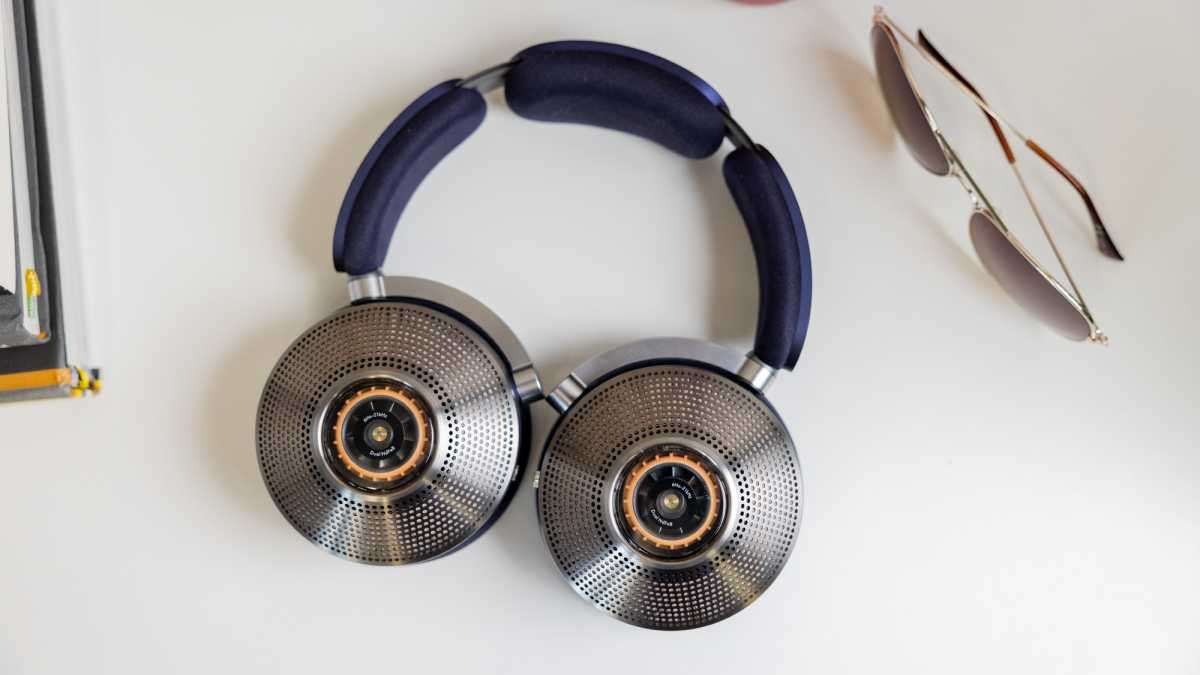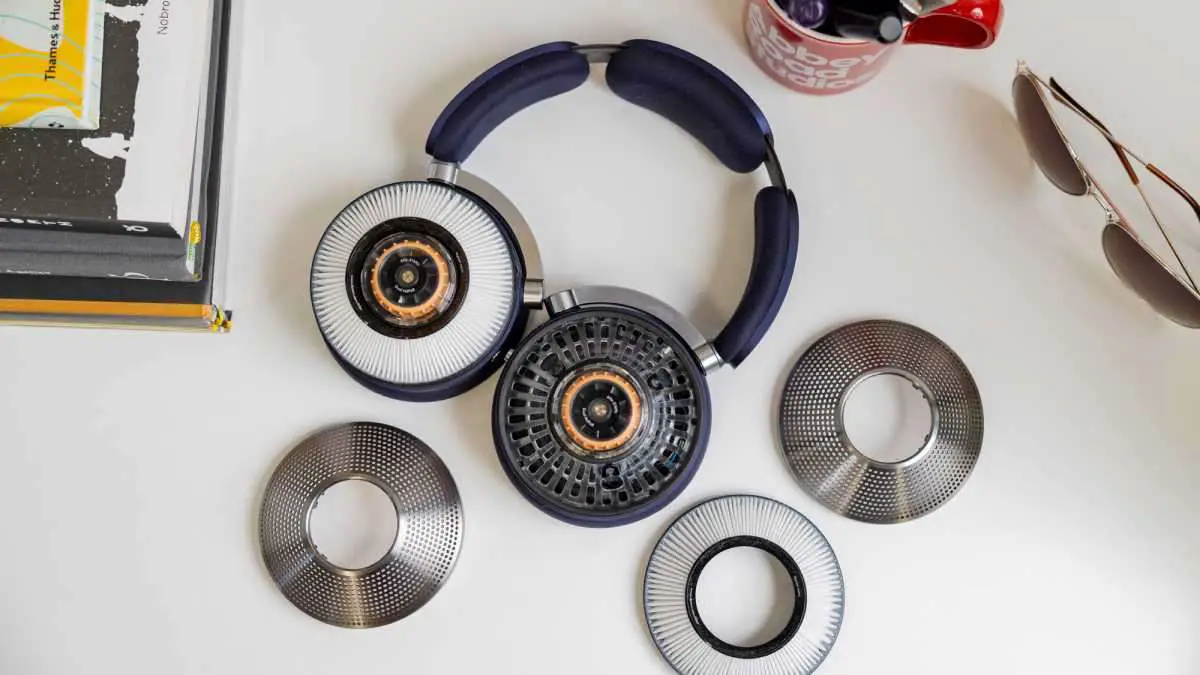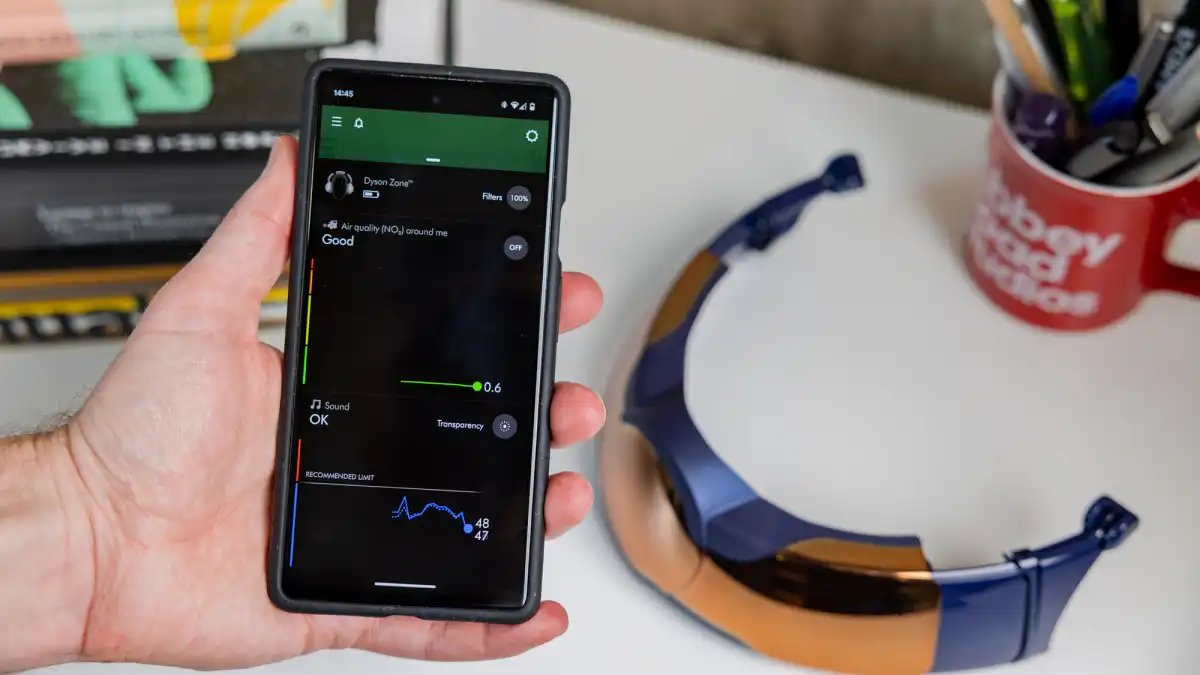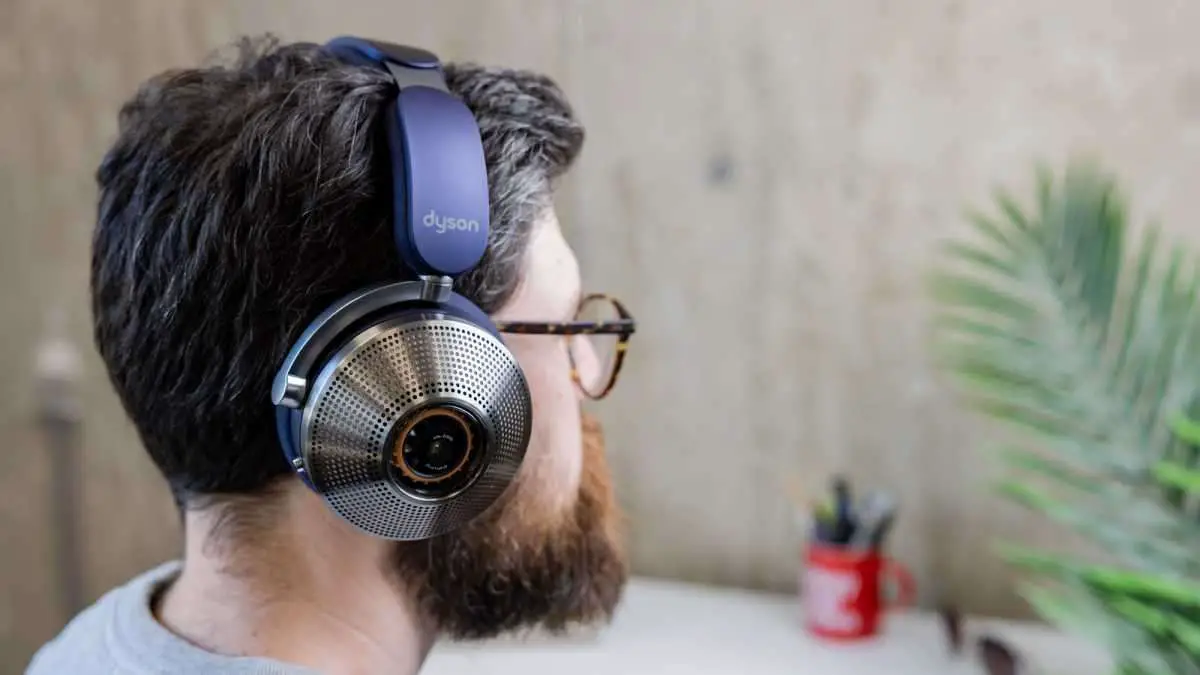Dyson’s first set of headphones took six years of research and development, as well as no fewer than 500 prototypes.
The Zone, on the other hand, are not your average set of noise-cancelling headphones since they can cleanse the air around you.
Despite their unique capabilities, Dyson is marketing them as headphones first. As a result, the visor that guides air to your face is detachable, allowing you to use it whenever you want – or never, if you feel too self-conscious wearing it.
In addition to the social component, there are additional impediments here, such as the substantial weight of the headphones (even without the visor) and the high asking price. The Dyson Zone has limited popularity, especially in Western areas where mask-wearing is not the norm. However, if you’ve been seeking for high-performance air purifying headphones, you’re in luck.
Design & Build
- Stylish but bulky
- Impressive engineering
- Plasticky visor
The Dyson Zone headphones are, on the whole, well-made.
The headphones themselves are quite luxury in appearance and feel. The Absolute+ type I tried is Prussian Blue/Bright Copper, whilst the cheaper alternative is a brighter Prussian Blue/Dark Blue with silver accents.
The earcups’ cones are detachable so you may insert/swap the air filters (which last up to a year), and the earcups fold to make the Zone more portable. Each ear cup has a glass window in the center so you can watch the fan whirling around. This is also a touch sensitive region for switching between active noise cancellation (ANC) and aware mode, although it is insufficiently responsive and requires vigorous taps.
The Absolute+ comes with a huge hard case that seems to hold a pair of binoculars.

They’re mostly constructed of metal and soft stuff, and I think they’re very cool. That is, assuming you don’t mind wearing large headphones, which they are, even for over-ear cans. With all of the technology within, it’s maybe not surprising that the Zone weighs 595g without the visor.
The visor only adds 75g, but that means it has to be made of fragile plastic and feels like something out of a kid’s superhero costume. It is magnetically attached, and I go into greater detail about the visor in the air filtration part below.
Because of their weight, they are more suited to sitting in a comfy chair at home rather than wandering around on the streets, however strolling around on the streets is when you are most likely to require air filtration. Even sitting at my computer, I found them uncomfortable after a couple of hours.

Because they are pleasant in other respects, such as the delightfully smooth micro-suede ear cushions, this is due to the weight. Surprisingly, only the top pad of the headband is soft, while the side ones are solid, however my head shape prevented them from making contact.
The fan button on the left earcup not only adjusts the fan speed, but it also controls the power and Bluetooth connectivity, which is really perplexing. Dyson should have just added another button for those.
The visor only adds 75g but this means it needed to be flimsy plastic and feels like something off a kid’s superhero fancy dress outfit
Another fault in the design, at least in my experience, is that when I reached for this button or the joystick on the opposite earcup, I nearly invariably brushed my finger against the mesh area with a mic concealed behind it, resulting in a loud scraping sound in my ears.

Air Purification
- Surprisingly pleasant
- Live monitoring but no notification
- Visor can be awkward
The Dyson Zone are headphones with an added feature, but the air purification is the main attraction here. The company has managed to put identical technology to its air purifying fans like the Pure Hot + Cool into some over-ear cans in a feat of engineering.
Read also : Sony WF-1000XM5 info
The small fans take air in via the ear cups and then push it through the contact-free visor, blowing clean air towards your mouth and nose. Dyson claims that the two-stage filtration system can remove “city fumes, viruses, and 99% of ultrafine pollutants,” including allergens and particles as small as 0.1 microns.
Now that I can’t test it, I’ll have to rely on Dyson’s word. What I can tell you is what it’s like to use.

Leaving the fan on auto mode allows the Zone to pick between three different speeds. Faster speeds are required for more vigorous activities rather than when the air is filthy.
It’s an odd experience at first, but I quickly got used to it and noted the change when I removed the visor. In fact, as the ‘new vehicle’ scent in the air subsided after a few of days, I found it rather nice.
In a marvel of engineering, the firm has managed to pack similar technology to its air purifying fans like the Pure Hot + Cool into some over-ear cans
Although I found it to be rather pleasant to use, there are a number of drawbacks and hassles to utilizing the headphones in air purification mode.
First and foremost, do you require the air around you to be cleaned? The answer, according to the My Dyson app, is nearly usually no. That’s almost likely true if, like me, you spend a lot of time sitting in your home office, but testing the Zone while travelling to our London office revealed that the air quality was well inside the ‘Good’ green zone – even outside in central London.

I did see it reading yellow (Oh oh) on the train into London, but it didn’t remain that way for long. Surprisingly, the headphones monitor the atmosphere around you in real time but do not notify you if the air quality drops, indicating that you should put on the visor. You must keep manually checking by launching the app.
Another significant hurdle is if you are comfortable wearing the Zone with the visor connected in public. Almost everyone I’ve asked has said “No” with a capital N, which I don’t blame them for.
These wouldn’t have looked out of place before the outbreak, but now you’ll stick out like a sore thumb wherever you go. I’m an introvert who dislikes being around others, and the thought of wearing the visor in public made me sick.
For the purpose of the review, I overcome my nervousness and received comments ranging from double takes to complete bafflement. Wearing the Zone could seem more normal in areas where mask-wearing is popular, such as China.

The last concern is the fit, since the visor is extensible but has some uncomfortable components in the way it operates. Because the visor is not adjustable in height, you must move the full set of headphones to correctly align them with your mouth and nose.
This required me to move the headband much further back on my head than I normally when not wearing the visor, which is more unpleasant.
The visor also folds down on hinges towards your neck, allowing you to swiftly converse or sip your coffee. This will also silence your audio and turn ANC to its transparency mode by default.
That’s OK, and you can turn it off in the settings if you want, but if you have a longish beard like me, the difficulty comes when you try to put the visor back on your face. My beard is carried along for the voyage and must be uncomfortably placed back where it belongs.
Mid-pandemic, these wouldn’t have looked totally out of place, but now you really are going to stand out like a sore thumb wherever you go
Sound Quality & ANC
- Custom 40mm drivers
- ANC with two modes
- Three EQ settings
Now that we’ve addressed the slightly insane sci-fi part, let’s see how the Zone performs as pure headphones. They’re Bluetooth 5.0, but if you purchase the in-flight kit (included with the more expensive model), you can also use a headphone jack because it comes with a cable that fits into the Zone’s USB-C connection.
According to Dyson, the massive ear cups house purpose designed 40mm neodymium drivers that produce “a broad frequency range for absolute clarity in bass, mids, and highs.”

One thing is certain: the Dyson Zone sound fantastic and are one of the best over-ear headphones I’ve heard in a long time. In the app, there are three EQ settings to pick from: Enhanced, Bass Boost, and Neutral.
I alternated between the first two settings depending on what I was listening to, but the normal Enhanced level works well for most stuff.
The Dyson Zone has warm, deep bass tones, but it also has a wonderfully detailed and clear sound in the mid and high tones. The audio has a highly dynamic and live presence that is incredibly engaging and fascinating.
… the Dyson Zone sound amazing and are sonically one of the best pairs of over-ear headphones I’ve tested
If you turn up the level, there’s very little distortion, but if you’re concerned about hurting your hearing, you can set an 85dB restriction in the app.
Active noise cancellation is also on par with Sony and Bose. This is due in part to the headphones’ excellent noise isolation, as well as no fewer than eight ANC-specific microphones.
The Zone can simply exclude external stimuli such as traffic and speech. It’s a shame you can’t alter the volume, but you can use the Transparency mode to deliberately hear what’s going on around you.

Regrettably, you can’t turn off ANC using the touch controls, so you’ll have to use the My Dyson app.
It’s worth mentioning that when you use the visor, you may occasionally hear the fans. On the slowest speed, the whirring is relatively mild and easily covered by music and ANC, but it gets more noticeable when you use the greater settings, which might contaminate sensitive passages of songs.
Battery Life
- Up to 50 hours
- USB-C charging
- Auto-off sensors
Dyson claims a phenomenal 50 hours of battery life for the Zone when ANC is turned on. When employing air purification, though, you will not reach anywhere near that figure. The company claims that with the fan at the lowest setting and ANC turned on, you’ll only get four hours.
When the battery hits a ‘critical’ level, the air purifying component is disabled, leaving you with only audio and ANC.
A full charge will take around three hours, and sensors can detect when you remove the headphones and immediately halt music and turn down the fans to help conserve the battery.

Price & Availability
The Dyson Zone headphones are not inexpensive, as you might expect. They are one-of-a-kind and have an astounding level of engineering to incorporate air purifying technology.
Still, I doubt anybody anticipated them to start at $949.99/£749.99 for the standard model. The nicer-looking Absolute+ model (unique to the official shop) reviewed here costs $999.99/£819.99 and comes with an Explorer Case, soft bag, and in-flight kit.
In the US you can buy the Zone headphones from Dyson or BestBuy. In the UK you can choose from the official store, Currys and John Lewis.
Verdict
Because it is so unique, the Dyson Zone is difficult to summarize in this circumstance.
They are an engineering and technical wonder on the one hand, but a clunky and difficult proposition on the other.
They are an excellent pair of headphones. In terms of construction, audio quality, and ANC performance, it ranks among the finest, with the added benefit of providing exceptional battery life when used only for listening.
When you factor in the air purification, the visor feels cheap, and the social embarrassment of wearing it in public will turn most people off – especially in the shy UK. Even if you don’t mind the attention, the app’s environmental monitoring indicates that it’s rarely required.
The Dyson Zone headphones are tough to suggest since they are both too hefty and too pricey. Even if you can stomach the latter, you must utilize the air purifier to justify the expenditure.
Specs
- 200 x 210 x 240mm (with visor)
- 595g (no visor)
- 670g (with visor)
- 11 total microphones for ANC and telephony
- ANC up to 38dB
- Transparency mode
- Auto Mode (with activity detection)
- Air quality sensors
- 6Hz – 21kHz frequency response
- 0.08% @ 94dB 1kHz distortion
- Bluetooth 5.0
- SBC, AAC & LHDC codec support
- 40mm neodymium drivers
- Filter efficiency is 99% at PM0.1
- Can capture NO2, SO2 and O3 gases
- Filters last up to 12 months
- 2,600mAh battery
- 50 hours of audio
- Low-flow up to 4 hours
- Mid-flow up to 2.5 hours
- High flow up to 1.5 hours
- USB-C charging
- 3-hour charge time
- 3.5mm via USB-C cable
- MyDyson app support


